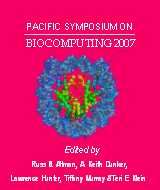Protein Interactions and Disease Phenotypes in the ABC Transporter Superfamily
Kelly L, Karchin R, Sali A
Program in Biological and Medical Informatics, Departments of Biopharmaceutical
Sciences and Pharmaceutical Chemistry, and California Institute for Quantitative
Biomedical Research, University of California at San Francisco QB3 at Mission Bay,
Office 503B, 1700 4th Street, San Francisco, CA 94158, USA.
Pac Symp Biocomput. 2007;:51-63.

Abstract
ABC transporter proteins couple the energy of ATP binding and hydrolysis to substrate transport across a membrane. In humans, clinical studies have implicated mutations in 19 of the 48 known ABC transporters in diseases such as cystic fibrosis and adrenoleukodystrophy. Although divergent in sequence space, the overall topology of these proteins, consisting of two transmembrane domains and two ATP-binding cassettes, is likely to be conserved across diverse organisms. We examine known intra-transporter domain interfaces using crystallographic structures of isolated and complexed domains in ABC transporter proteins and find that the nucleotide binding domain interfaces are better conserved than interfaces at the transmembrane domains. We then apply this analysis to identify known disease-associated point and deletion mutants for which disruption of domain-domain interfaces might indicate the mechanism of disease. Finally, we suggest a possible interaction site based on conservation of sequence and disease-association of point mutants.
[Full-Text PDF] [PSB Home Page]